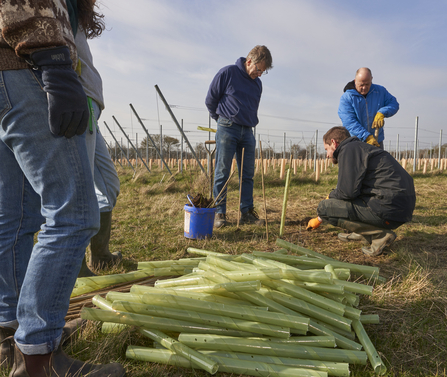It was a type of day where you look out of your window and are content in pottering around the house, whilst the continuous rain and wind was tapping at the window. However, this was not the case for Surrey Wildlife Trust’s Central Team, and their brilliant volunteers.
The volunteering project
Meeting at Shere Car Park, the three team leaders gathered their twelve volunteers, all of whom were layered up with coats and base layers, with waterproofs from head to toe, ready for work to be done in conserving and creating new wildlife links in the countryside. We walked to the field where we were continuing the 200m planting of hedge saplings in order to form a new hedgerow across a cattle field to connect two habitats, sectioned by maintained field. This would create a wilderness corridor which promotes and accumulated a multi-biodiverse ecosystem as well as a divider for the National Trust’s land (pre-organised with Surrey Wildlife Trust). We were to plant saplings, which would later, not completed by the volunteers, be fenced parallel to the hedge until it is secure in its shape and volume.
Beginning my volunteer journey
This was my first time volunteering in the outdoors with Surrey Wildlife Trust, and to say that I was very eager is an understatement. I love the practical work of doing things that will directly help nature, a factor that was agreed with greatly amongst the volunteers.
Many of the volunteers there were regular attendees, supporting the productivity of Surrey Wildlife Trust’s practical work. I quickly realised how crucial it is for the Trust that volunteers are happy to join and help, as it makes the work quicker and more enjoyable for everyone involved, and creates a positive community.
I asked a few volunteers about how they started volunteering for Surrey Wildlife Trust, and how they found out about the specific locations and timings of the volunteer work. The reply was an obvious “Simple! You sign up and receive an email on Thursdays via the volunteer email after signing up. We then see our availability and reply ‘yes’, and then ask the regulars (the other volunteers that often helped out) to see which of us will keep each other company”. (This is your sign to sign up to the Surrey Wildlife Trust’s volunteer list!)
The volunteers I met were and are a group of truly lovely people. All of them positive, despite the rain, and very practical people on the basis that they knew what exactly they were doing. Both the volunteers and the Trust’s leaders made the experience feel very welcoming, and even more enjoyable as we are all there for the same purpose and have a love for nature.


